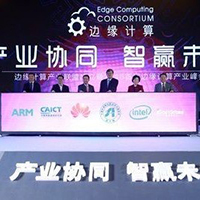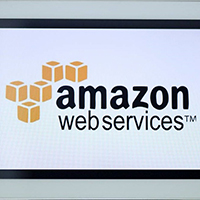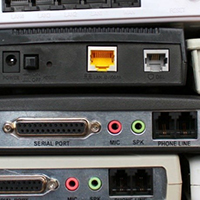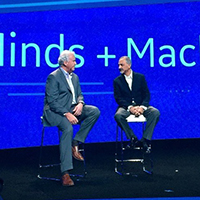In This Issue
- ECC Now Established
- IoT: DC Cool Again
- AWS Cybersecurity
- Report from the CEO
- SMB Need: Get Smart
- Hackers New Botnet
- IoT Research Hacking
- Optimization Curve
- Hybrid Cloud Security
- Not Using Automation
- Competition Heats Up
- Cloud Risk Ownership
- 10 Mind Blowing Stats
- File Sync and Share
- Cloud & Data Center
- Cloud Holds Future
- Coming DCIA Events
Edge Computing Consortium Officially Established
Excerpted from Yahoo Finance Report
 Today, the Edge Computing Consortium (ECC) was officially established in Beijing, China.
Today, the Edge Computing Consortium (ECC) was officially established in Beijing, China.
This initiative was jointly created by Huawei Technologies, Shenyang Institute of Automation at the Chinese Academy of Sciences, China Academy of Information and Communications Technology (CAICT), Intel Corporation, ARM, and iSoftStone.
The ECC aims to build a cooperative platform for the edge computing industry that will give impetus to openness and collaboration in the operational technology (OT) and information and communications technology (ICT) industries, nurture industrial best practices, and stimulate the healthy and sustainable development of edge computing.
Today’s global digital revolution is driving a new round of industrial restructuring.
Through the digital transformation of industries, products are incorporated into intelligent interconnection.
In-depth coordination and convergence of OT and ICT will help improve industrial automation, meet the customized requirements of products and services, promote full-lifecycle transformation from products to service operations, and trigger the innovation of products, services, and business models… Read More
IoT Makes Distributed Computing Cool Again
Excerpted from TechTarget Report by Adam Wray

In part one of our examination of the distributed computing lexicon, we discussed the importance of ensuring data availability and usability in distributed internet of things (IoT) architectures.
In order that data remain always available for our applications, we must construct distributed infrastructures so that if one node or network component fails, the data it houses is still accessible from other nodes of the same system.
Usability refers to limiting latency as data volume grows and demand from dispersed geographies and disparate networks expands.
In this second part, we’ll look at what it means to achieve data accuracy and ease of operational support while maintaining cost effectiveness.
A traditional database holds data for transactional systems.
Transactional systems ensure data accuracy by serializing updates to the data.
This ensures data accuracy in a scenario with multiple potential writes to a data record… Read More
Amazon Unveils New Cybersecurity Service
Excerpted from Wall St. Journal Report by Jay Green and Laura Stevens

Amazon’s cloud-computing unit unveiled a new service to help protect customers against cyberattacks of the sort that rendered dozens of popular websites unreachable for parts of a day last month.
Amazon Web Services introduced AWS Shield, a service that will be turned on by default for its customers.
The company said that Shield will help customers defend against so-called distributed denial-of-service (DDoS) attacks that can knock websites offline by flooding them with junk data, blocking the way for legitimate users.
“This will really help you protect yourselves even against the largest and most sophisticated attacks that we’ve seen,” said Werner Vogels, Amazon Chief Technical Officer at the annual conference for the retail giant’s cloud computing unit here.
The company is offering two levels of protection.
AWS Shield Standard monitors incoming web traffic for customers and uses anomaly algorithms and other analysis techniques to detect malicious traffic in real-time.
The company also announced AWS Shield Advanced, a version designed to protect against more aggressive and sophisticated attacks… Read More
Report from DCIA CEO Marty Lafferty
 In his recent video message, US President-elect Donald Trump committed to task the Joint Chiefs and Department of Defense (DoD) with developing a plan to protect critical infrastructure from cyberattacks.
In his recent video message, US President-elect Donald Trump committed to task the Joint Chiefs and Department of Defense (DoD) with developing a plan to protect critical infrastructure from cyberattacks.
Engaging the military to address threats to power plants, electricity grids, public transportation systems, and telecommunications networks – areas that are essential to national security and already have significant government involvement at federal, state, and local levels – makes sense; and the first priority task should include shoring up government IT systems.
As recent attacks have demonstrated, there is no reason to expect that adversaries will not continue to target political entities and step-up attacks on government agencies.
The DCIA believes that the best way to protect our networks is for the public and private sectors to work together, and the Trump administration has an unprecedented opportunity to help businesses realize the benefits of joining forces with the government on information security.
The challenges here are different from blocking conventional weapons, like missiles or bombs, which are discernible as physical objects, because cyberattacks are hidden inside benign traffic, which routinely crosses the internet.
Government agencies use mobile devices, cloud services, and related networked-computer technologies, as do private enterprises and consumers, providing access points and pathways for carrying out such attacks.
While cyberspace is different from conventional arenas where warfare is conducted, government responsibility in the digital age must extend to this domain given the strategic importance of electronic data flow to the lives of all citizens.
Beyond malware, ransomware, phishing scams, and other common attack vectors, utility providers need to update their industrial control systems to include active monitoring for intrusions.
Implementing multi-factor authentication for accessing sensitive systems and staying current in the application of software patches are two easily achievable, quantifiably measurable, near-term tactics.
A critical issue will be protecting the privacy and integrity of consumer and industrial data while perfecting new protocols for accessing and ultimately anticipating the sources and eliminating the actual malware responsible for cyberattacks.
Engaging private sector experts from the major broadband network operators, software developers, and cybersecurity solutions providers, such as Crowdstrike, FireEye, and IronNet, to partner with military leaders will also ensure protection of Fourth Amendment rights against unwarranted government searches.
Cyber Command has both a major opportunity as well as a tremendous need to address in developing a technologically advanced plan that anonymizes sensitive private sector data while efficiently identifying and eradicating harmful traffic – as it also develops powerful offensive cyber-weapons to serve as deterrents.
Keeping America great includes ensuring that its critical national infrastructure is safe, and information security should be a top priority to be addressed within the new President’s first hundred days in office. Share wisely, and take care.
SMBs Should Get Smart about Information Security
Excerpted from JDSupra Business Advisor Report by Josephine Cicchetti

The latest publication by the National Institute of Standards and Technology (NIST), entitled Small Business Information Security: The Fundamentals, aims to promote and assist small businesses in their efforts to manage information security risks.
Written by Celia Paulsen and Patricia Toth, the report speaks directly to the needs of growing businesses and suggests that the security of information, systems, and networks should be a top priority.
Overall, the report explains some of the security issues unique to small businesses and offers a guideline for safeguarding information to help those businesses thrive.
Below are several key takeaways from the report.
In many ways, small businesses have even more to lose than large ones simply because an event – whether a hacking, natural disaster, or business resource loss – can be incredibly costly.
The report begins by noting that while cybersecurity improvements by some businesses have rendered them more difficult attack targets… Read More
Hackers Create Massive New IoT Botnet
Excerpted from Motherboard Report by Lorenzo Franceschi-Bircchierai
 The massive cyberattacks that in the last few weeks have crippled several popular services like Twitter and Spotify, the website of a noted security journalist, and many more, may be about to get worse.
The massive cyberattacks that in the last few weeks have crippled several popular services like Twitter and Spotify, the website of a noted security journalist, and many more, may be about to get worse.
Two hackers appear to have created a new powerful zombie army of hacked internet of things (IoT) devices with a modified version of the infamous malware Mirai.
The cybercriminals are offering the powerful botnet to anyone who’s willing to pay to launch crippling distributed denial-of-service (DDoS) cyberattacks.
Last month, unknown attackers intermittently knocked offline several popular websites like Twitter, Spotify, and many others using Mirai, a now-widespread type of malware created to automatically scan the internet for easy-to-hack devices and turn them into bots that can launch DDoS attacks.
Now, two cybercriminals claim to have improved Mirai to infect new devices – mostly routers.
This new variant gives them the ability to potentially harvest hundreds of thousands, perhaps millions, of new bots… Read More
Government to Allow IoT Hacking for Research
Excerpted from MediaPost Report by Chase Martin

Security professionals can now hack IoT devices without breaking the law, thanks to an updated ruling in the US Copyright Office.
The new rule under the Digital Millennium Copyright Act (DMCA) permits security researchers to legally circumvent device manufacturers’ software to control connected devices.
Such devices include all wearable devices, smartphones, tablets, removable wireless broadband modems and similar devices.
The rule requires the hacking to be conducted in a controlled environment, for research purposes and not to be exploited maliciously.
The Internet of Things has been an area of focus for many security professionals working to uncover potential vulnerabilities for device manufacturers.
For example, teams of security experts broke through twelve of sixteen smart lock systems, as well as a smart thermostat at a recent hacking conference… Read More
Cutting Decades out of the Optimization Curve
Excerpted from Automation World Report by David Greenfield
 “There’s a lot of sensor technology already in place across industry,” said Steven Martin, Chief Digital Officer at GE Energy Connections.
“There’s a lot of sensor technology already in place across industry,” said Steven Martin, Chief Digital Officer at GE Energy Connections.
“What we’re trying to do is reduce the time it takes for an operation to get to an efficient state.”
Explaining his statement, Martin said that end-users have been optimizing equipment in place the same way for years using basic operating data gathered from sensors and controllers.
However, if you put more sensors in these assets to extract more data for greater levels of analysis and insight with integrated applications, you can get the yield up on those assets very quickly, he said.
“As we’ve seen with applications in the renewable energy industry, you can cut decades out of optimization curve.”
It’s around this vision of speeding optimization and remaking industries across supply chains that GE sees its future.
Over the past few years, GE has been on a path to realign its business as a software company enabling the Industrial Internet (GE’s preferred term for the Industrial Internet of Things)… Read More
Clearing the Fog: Vision for Hybrid Cloud Security
 Have you ever driven on a high road or mountain pass that’s shrouded by low cloud?
Have you ever driven on a high road or mountain pass that’s shrouded by low cloud?
You’re at the familiar controls of your vehicle, but you can’t easily see road-signs, oncoming vehicles, which way the road goes, or other dangers.
Progress can be hazardous unless you take extra precautions.
The feeling will be familiar to many organizations’ IT teams as they transition some of their business applications and data to the cloud.
The majority of organizations don’t have a large, centralized cloud deployment that has completely replaced their physical networks simply because this type of wholesale migration is costly and involves a great deal of planning, resources, and risk.
Instead, most enterprises have a hybrid model that includes a mix of physical data centers and private or public clouds.
A recent forecast from 451 Research predicted 60 percent of enterprise workloads will run in the cloud by mid-2018, up from 41 percent today… Read More
SMBs Not Using Automation for Cloud Backups
Excerpted from CloudTech Report by James Bourne

Almost 70% of small businesses in a survey from B2B analyst and reviews firm Clutch say they rely on their cloud storage provider for backups, with only 15% opting for automated services and 12% not bothering at all.
The findings appear as the second of two reports on SMBs and cloud strategy, with the first in November advising that many small firms are risking their security by choosing free storage products.
This time, the warning is around using their providers for backing up data in the cloud.
As this publication has examined on various occasions, while the need for backup is rare, it’s always better to prepare for an unlikely event than be caught unawares.
If the company was not utilizing an automated service and forgot to back it up, then they have no other options.
Clutch recommends Mozy and Carbonite as providers who help with the automation side of backup.
“If I put a file in Dropbox, it’s going to be there,” said Mark Estes, regional director of sales at big data firm Qubole. “If I don’t back it up, then Dropbox can’t help me with that… Read More
Competition Heats up for Growing Cloud Computing Market
Excerpted from Report by Yonhap News Report by Kim Deok-hyun
 Competition is intensifying among foreign and local technology firms in South Korea’s market for cloud computing as the market is expected to grow at double digit annual rates in coming years.
Competition is intensifying among foreign and local technology firms in South Korea’s market for cloud computing as the market is expected to grow at double digit annual rates in coming years.
Cloud computing is an Internet-based computing service that rents data storage and computing power to individual users or corporate customers.
It allows users to save and process their data using a remote server, instead of using their local server or personal computers.
According to a recent study by the National IT Industry Promotion Agency (NIPA), the Korean market for cloud computing jumped 46.3 percent on year to $657.1 million last year.
Last year, only 6.4 percent of Korean firms used cloud computing services, according to the report. This year, about 10 percent of local firms are expected to use the service and as many as 30 percent of local firms are forecast to use the service in two or three years.
Cloud computer services have become one of the core infrastructures for Internet of Things (IoT) technology… Read More
Ownership of Cloud Risks Lost in Many Scenarios
Excerpted from TechTarget Report by Dave Shackleford

Companies want to use cloud-based services and applications; thus, security teams need to assess the risk and come up with controls that work in cloud environments.
Sounds simple, right?
Securing cloud assets presents numerous challenges, however — from controls that don’t translate well to lack of transparency from cloud providers.
And one of the most pressing concerns sits squarely with the CISO: pushing for more ownership of cloud risks within the business.
CISOs juggle a lot of security responsibilities, including overseeing technical project teams and communicating cloud risks and possible resolutions to other executives and board members.
Unfortunately, it’s a common misperception that the information security organization “owns” the risks of IT projects, whether on premises or in the cloud… Read More
10 Cloud Stats Will Blow You Away
Excerpted from Motley Fool Report by Leo Sun
 In a previous article, I explained some of that jargon and highlighted three key cloud stocks — Amazon, Microsoft, Salesforce.
In a previous article, I explained some of that jargon and highlighted three key cloud stocks — Amazon, Microsoft, Salesforce.
Today, I’ll review 10 key industry stats that should give investors a better grasp on the growth of the cloud computing market.
1. The worldwide cloud computing market grew 21% to $110 billion in 2015 according to Synergy Research Group.
That total includes cloud infrastructure services, software services, and hardware.
2. 17% of enterprises run over 1,000 VMs (virtual machines) in the public cloud, compared to 13% in 2015, according to RightScale’s State of the Cloud survey.
That’s great news for public cloud leaders like Amazon and Microsoft.
3. Worldwide spending on public cloud services could double from almost $70 billion in 2015 to over $141 billion in 2019, according to research firm IDC… Read More
Enterprise File Sync and Share Business Grows
Excerpted from CRN Report by Joseph Kovar
 The cloud-based file sync and share market is a fast-growing opportunity for solution providers helping businesses find a way to add enterprise control to employees’ communications which, if not carefully managed, could result in compromised data.
The cloud-based file sync and share market is a fast-growing opportunity for solution providers helping businesses find a way to add enterprise control to employees’ communications which, if not carefully managed, could result in compromised data.
It is also a fragmented market, one characterized by a wide range of vendors — from a handful serving corporate users with tools providing file access and collaboration tools tailored to a business’ policies to a multitude serving either end-user consumers or business users who cannot wait for their IT teams to put corporate policies in place.
Enterprise file synchronization and sharing is an on-premise or cloud-based offering that allows users to synchronize files or share them with others via PCs and mobile devices, either within or outside a business, depending on how it is deployed.
It is a key part of business’ mobility plans as it allows mobile users to ensure they have access to updated business documents and are able to share them based on corporate policies.
It is the kind of market where a solution provider has an opportunity to make a huge difference for customers of all sizes, especially smaller companies struggling to take advantage of the cloud, said Larry Velez, founder and chief technology officer at Sinu, a New York-based managed services provider… Read More
5 Trends for Cloud & Data Center in 2017
Excerpted from Information Management Report by David Weldon
 Investments in cloud computing will continue aggressively in 2017, but many organizations will opt for multi-cloud environments in their data centers.
Investments in cloud computing will continue aggressively in 2017, but many organizations will opt for multi-cloud environments in their data centers.
That is the prediction of Avinash Lakshman, Chief Executive Officer at Hedvig and creator of Apache Cassandra.
Avinash spoke with Information Management about what the New Year will hold for data and IT professionals. He sees five key trends for the cloud and storage markets.
“With many companies making investments in public and private cloud services, 2017 will see more businesses committing to multiple cloud providers at the same time,” Lakshman predicts.
“For example: there will be fewer and fewer Amazon Web Services-only businesses; rather dual-source public cloud services will be used instead to avoid vendor lock-in.
The challenge will come in making data services easy and productive across multiple clouds.
Without this function, enterprise deployments will be as inefficient as they were when they were using tape… Read More
Cloud Computing Holds the Future
Excerpted from Dataquest Report by Biswas Nair
 With digital transformation, organizations across the industries have been steadily shifting towards cloud-first strategies.
With digital transformation, organizations across the industries have been steadily shifting towards cloud-first strategies.
Most of the technology innovation has become cloud-centric today.
This shift has brought in operational agility for the businesses with growing or fluctuating demands.
The ease of setup and management of IT hardware seems to be simplified with the pay as you go model offered by cloud.
In addition, collaborating with teams, editing and sharing documents, and remote accessing has become much easier.
Cloud has driven offerings also take care of corporate data security and other aspects like providing sustainable solutions.
According to Gartner, there will be continual and rapid growth of cloud adoption, trending towards public cloud.
The public cloud service market is expected to grow 17.2 percent in this year.
In fact, cloud application services that cater one of the largest segments in the global cloud services market is expected to grow 21.7 % to reach $38.9 billion… Read More
Coming Events of Interest
Government Video Expo — December 6th-8th in Washington, DC. GVE is the East Coast’s largest technology event for broadcast and video professionals, featuring a full exhibit floor, numerous training options, free seminars, keynotes, panel discussions, networking opportunities, and more.
CES 2017 — January 5th-8th in Las Vegas, NV. More than 3,800 exhibiting companies showcasing innovation across 2.4 million net square feet, representing 24 product categories.
Industry of Things World USA — February 20th-21st in San Diego, CA. Global leaders will gather to focus on monetization of the Internet of Things (IoT) in an industrial setting.
fintech:CODE — March 16th-17th in London, UK. A new international knowledge exchange platform bringing together all DevOps, IT, and IoT stakeholders who play an active role in the finance and tech scene. Key topics include software development, technical challenges for DevOps, DevOps security, cloud technologies and SaaS.
retail:CODE — March 16th-17th in London, UK. 20 real-life case studies, state-of-the-art keynotes, and interactive World Café sessions, 35+ influential speakers will share their knowledge at the intersection of the retail and technology sectors.
Delivery of Things World — April 24th and 25th in Berlin, Germany. Over 400 IT executives will discuss what DevOps really means for business. This event brings together all stakeholders to share their experience and expertise.
